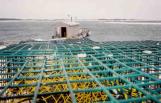25
It's a stunning feat compared to fifty years ago, when a fishermen might have had 100-150 traps, and if his catch was even a few thousand pounds, he would have had to bring it ashore in trips, being as it was probably too heavy for his simple boat. He may have towed what was called a "flat," a sort of catch-carrying boat trailer, but even that might not have been enough sometimes.Before the internal-combustion engine, fishing boats were powered by sail or by oar.
An 18-20 foot oared boat took three men to operate, typically a father and two of his sons, one on each oar, at starboard and port; dad hauling traps, by hand, from the stern.
Once the new engines had matured sufficiently, fishermen literally modified their automobile engines, complete with transmission, retrofitted from vehicle to vessel. Many powered their boats that way until Atlantic Motors of Lunenburg brought out the first boat engine. With 4-horsepower and 1-cylinder, and nothing but the Atlantic ocean for its cooling system, it could breakdown daily or never. But in either case a mechanical problem was easily fixed, given the simplicity of the machine; and in any case, it didn't matter how well they worked, just that they did: it was better than rowing!
Nicknamed "putt-putts," "tikky-tiks," and "make 'n' breaks," when these primitive engines got going there was no stopping them. Literally! The only way to put on the brakes, so to speak, was to pull the sparkplug wire off the engine, which could mean quite a shock for a fisherman's cold, wet hands. With the engine killed, the boat would cruise, steered only by a basic blade, toward the buoy. The trap would be hauled up, re-baited and set back for another catch. The sparkplug wire went back on, the engine was given a little kick, and off they went. Equally ad hoc manoeuvring was required for reverse: kill the motor, switch the timer around (which would change the propulsion system), and give it a kick - a precarious situation if the fisherman were headed bow-end into the side of some rocks in rough water.
It's all a far cry from today's "marine transmissions," sturdy, superior engines designed for big powerful boats. As dependable as they are sophisticated, one of the ironies of today's technology is that while the cutting-edge fibreglass boat itself is nearly indestructible - cutting down on maintenance in ways wooden boat builders may never have dreamt of - a mechanical problem today can be expensive and time-consuming, requiring mechanical, even electronic, expertise far exceeding that of even the most technically savvy of yesterday's fishermen. "If you put them on one of our boats," the fishermen say of their grandfathers, "they wouldn't know what to do."
So while the generations before may have built their own boats, hammered together their own wooden traps, and hauled up their catch all by hand, today's generation possesses an entirely new set of skills that would be as foreign to their great-grandfathers as vice versa. On top of being a carpenter, a fisherman today has to be a mechanic and a technician, not to mention a businessman.
It's a new self-sufficiency, but a self-sufficiency nonetheless. Indeed, the picture of the lone seamen, most at home in the solitary wilderness of the ocean, is no less recognizable in some of even today's most successful captains.
But just as in the old days, when community members relied on one another to collectively provide the necessities of life, fishing today is not a solitary career. There are "helpers" aboard each boat, for everything from preparing the bait, sorting and measuring the catch, and banding the lobster claws to lending a hand with a heavy catch or just being on hand to snap the photo!
No man is an island: A team is necessary considering the heavy machinery aboard some of today's boats - like huge crab traps which could fit several men inside them.
Until recently, cold, wet, endless rope stood between the fisherman and his catch, as traps had to be hauled up by hand.
Manual, and later mechanical, hydraulic-powered winches have since been introduced, either for winding the traps up to the surface, or for hauling up the trawl line (a buoyed line from which several shorter lines shoot, each with many baited hooks attached at intervals). The first fishermen to leverage the pulley system must have felt a similar sense of relief as those who exclaimed, about their prototype engines, that it was "better than rowing!"
Today's catch, not surprisingly, is five or six times bigger than yesterday's.
Traps have undergone a similar transformation, in the last thirty years, from all wood contraptions with handmade cotton twine mesh that needed to be soaked in tar to prevent it from rotting in the sun and replaced every 2-3 years; to half wooden traps with nylon meshing; to all-wire crab traps; and all-wire lobster traps; with heavy-duty nylon hauling rope and plastic-foam buoys built to stand the test of time and tide.
Wooden traps were light enough to float, so fishermen would use rocks, and later concrete slabs, to sink them. Today's wire traps have complimentary concrete footings, making one more tedious job - the practice of collecting rocks for sinking traps - obsolete.
All these changes may make the form, if not the function, of fishing itself increasingly unrecognizable compared to four hundred... one hundred... even fifty years ago. But something essential and unchangeable remains, perhaps in the fisherman himself. A saying goes: "You can make farmers into fishermen, but you can't make fishermen into farmers." Meaning that, for those born to live and work on the water, dry land is just a stopover between outings. The fisherman has salt-water "in his blood," and when the sea calls, nothing can stand between him and the ocean.
